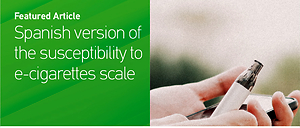Dear Editor,
According to the 2021 U.S. National Youth Tobacco Survey, 19.4% of middle and high school students reported ever use of electronic cigarettes (e-cigarettes)1. As noted in the 2022 U.S. Food and Drug (FDA) Administration’s Research Priorities, pressing issues include ‘innovative measures, methods, or study designs to assess the likely impact of electronic nicotine delivery systems (ENDS) and heated tobacco products (HTPs), other novel products, and/or potential modified risk tobacco products on relevant outcomes, including precursors to tobacco use (e.g. perceptions, intentions, susceptibility) …’2. Key to this work is the need for language-appropriate and validated instruments.
The susceptibility to e-cigarettes scale assesses behavioral intentions, peer influence, and self-efficacy in regard to e-cigarette use (vaping)3. Specifically, this scale consists of the questions: ‘have you ever been curious about using e-cigarettes?’, ‘do you think you will use e-cigarettes in the next year?’, and ‘if one of your best friends were to offer you an e-cigarette, would you use it?’3. Response options include: ‘not at all curious’, ‘a little curious’, ‘somewhat curious’, or ‘very curious’ for the first item, and ‘definitely not’, ‘probably not’, ‘probably yes’, or ‘definitely yes’ for the other two items3. Emergent literature has demonstrated that susceptibility to e-cigarettes, defined as the absence of a firm decision not to use e-cigarettes, is a strong independent predictor of future vaping3-5. Moreover, susceptibility to e-cigarettes has been proposed as an outcome for vaping prevention efforts6.
Despite the wide use of the susceptibility to e-cigarettes scale, to the best of our knowledge, there is no version in Spanish. Moreover, the psychometric properties of the scale (e.g. the internal consistency reliability) have not been established among Spanish speakers, inhibiting the confident use of the instrument in this population. The purpose of this article is to present the Spanish version of the susceptibility to e-cigarettes scale.
Data are from a randomized controlled trial to assess the immediate impact of vaping prevention graphic messages among 362 Black and Latino adolescents (aged 12–17 years), with equal representation between the two groups6-7. The study design and results are described thoroughly in a previous publication6. A forward-backward methodology was used to translate the susceptibility to e-cigarettes scale into Spanish8. Moreover, a Community Advisory Board of Latino adolescents reviewed and approved the translation. Table 1 shows the translation of the scale. Cronbach’s alpha was used to assess the internal consistency reliability of the questionnaire9.
Table 1
Spanish translation of the susceptibility to e-cigarettes scale
Sixty-five Latino adolescents completed the susceptibility to e-cigarettes scale in Spanish, as part of the baseline survey. The Cronbach’s alpha coefficient of the Spanish version of the susceptibility to e-cigarettes scale was 0.74. The introduced Spanish version of the susceptibility to e-cigarettes scale shows an acceptable internal consistency reliability, with potential applications in both research and clinical settings. The use of validated Spanish-language assessment tools – developed in collaboration with community members – is vital to advance vaping prevention research among Latinos. Future research should examine other aspects of instrument validity (e.g. predictive validity) and involve larger samples.


